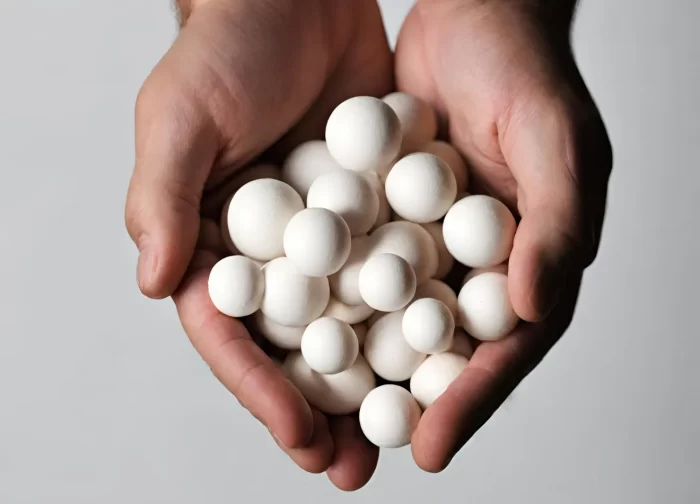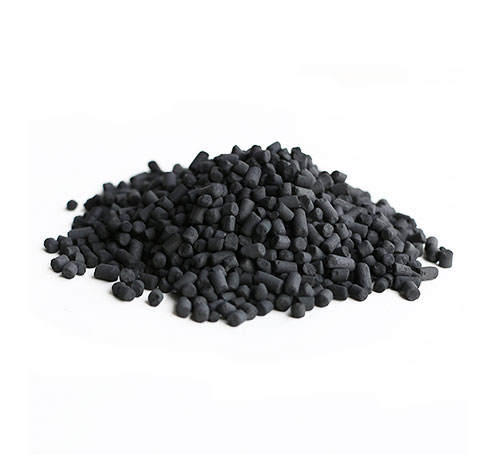Alumina balls, composed predominantly of aluminum oxide, stand as resilient and versatile ceramic spheres that have found integral roles across industries.
Renowned for their exceptional hardness, wear resistance, and chemical inertness, these small yet potent spheres play a vital part in applications ranging from grinding and milling to catalysis and electronics.
In this brief introduction, we explore the fundamental characteristics and diverse applications that make alumina balls indispensable contributors to the fields of materials science and industrial processes.

Alumina Balls
Alumina balls, a key player in the realm of advanced ceramics, are engineered spheres renowned for their exceptional properties and versatile applications. Crafted primarily from aluminum oxide (Al₂O₃), these ceramic balls exhibit a unique combination of high hardness, wear resistance, and chemical inertness.
As tiny powerhouses of durability, alumina balls find their place in various industrial arenas, from grinding and milling applications to catalysis and precision engineering. In this introduction, we delve into the characteristics and applications that make alumina balls indispensable across diverse industries, shaping the landscape of materials science and manufacturing processes.

Alumina Balls Uses
Alumina balls have a wide range of uses across various industries due to their unique properties, including high hardness, chemical inertness, heat resistance, and more. Here are some typical applications of alumina balls:
- Catalyst Support: Alumina balls are widely used as catalyst support materials in the petrochemical and refining industries. Their high surface area provides an effective platform for catalytic reactions.
- Grinding Media: Alumina balls serve as grinding media in ball mills, where they are employed to grind or blend materials. The high hardness of alumina contributes to efficient grinding, making them suitable for industries such as ceramics, paints, and minerals processing.
- Ball Bearings: In some specialized applications, alumina balls are used as components in ball bearings due to their hardness and wear resistance.
- Chemical Industry: Alumina balls are employed in various chemical processes where chemical inertness is crucial. They are used in reactors, columns, and vessels to provide a chemically inert environment.
- High-Temperature Applications: Due to their excellent heat resistance, alumina balls are used in high-temperature processes such as furnace linings, kiln furniture, and refractory applications.
- Electrical Insulation: Alumina's electrical insulating properties make alumina balls suitable for use in electrical insulators and components.
- Desiccant Balls: Alumina balls with controlled porosity are used as desiccants for moisture control in specific applications.
- Wear Protection: Alumina balls are used in wear-resistant linings and coatings to protect equipment from abrasion and wear in industries like mining, cement, and power generation.
- Filler Material: Alumina balls are added to various materials as fillers to enhance their properties. For example, they can be incorporated into plastics or rubber to improve hardness and wear resistance.
- Adsorption Beds: In applications such as gas chromatography and air separation, alumina balls are used in adsorption beds to separate and purify gases.
- Textile Industry: Alumina balls are sometimes used in the textile industry for applications like yarn conditioning.
The specific application of alumina balls depends on the properties required for the given process or product. Manufacturers often tailor the properties of alumina balls, such as size, shape, and purity, to meet the specific needs of different industries and applications.

Alumina Ball Mill
An alumina ball mill refers to a type of grinding mill containing alumina balls as the grinding media. This type of mill is effective for grinding and blending materials for use in mineral dressing processes, ceramics, paints, and pyrotechnics.
Here's a brief overview of how an alumina ball mill works:
- Loading the Mill: The alumina balls are typically added to the mill along with the material to be ground. The proportion of balls to material depends on the specific requirements of the process and the properties of the materials being processed.
- Grinding: As the mill rotates, the alumina balls inside it collide with the material to be ground. The high hardness of alumina helps in breaking down the material, resulting in the reduction of particle size. This grinding action is crucial in various industries where finely ground materials are required.
- Cascading and Tumbling Action: The rotation of the mill causes the alumina balls to cascade and tumble inside, creating an impact on the material. This action contributes to the effective grinding of the material.
- Control of Fineness: The fineness of the ground material can be controlled by adjusting factors such as the size and quantity of alumina balls, the rotational speed of the mill, and the duration of milling.
- Applications: Alumina ball mills find applications in industries such as ceramics, chemicals, paints, and mineral processing. They are often used for grinding materials into fine powders, mixing them, or blending different materials.
- Ceramic Lining: Many ball mills designed for grinding with alumina balls have a ceramic lining to protect the mill's inner surface from wear and abrasion caused by the grinding action.
Alumina balls are preferred for ball milling processes due to their high hardness, wear resistance, and chemical resistance. The choice of alumina balls and the design of the alumina ball mill depend on the specific requirements of the process, including the type of material being ground and the desired final product characteristics.
Conclusion
Alumina balls stand out as versatile and resilient materials with a broad spectrum of applications. Their remarkable hardness, chemical inertness, and high-temperature resistance make them indispensable in industries ranging from petrochemicals to ceramics and beyond.
Whether serving as catalyst supports, grinding media, or wear-resistant components, alumina balls consistently deliver effective performance. As key contributors to wear resistance, electrical insulation, and high-temperature processes, alumina balls play a pivotal role in enhancing the efficiency and durability of various industrial applications.




